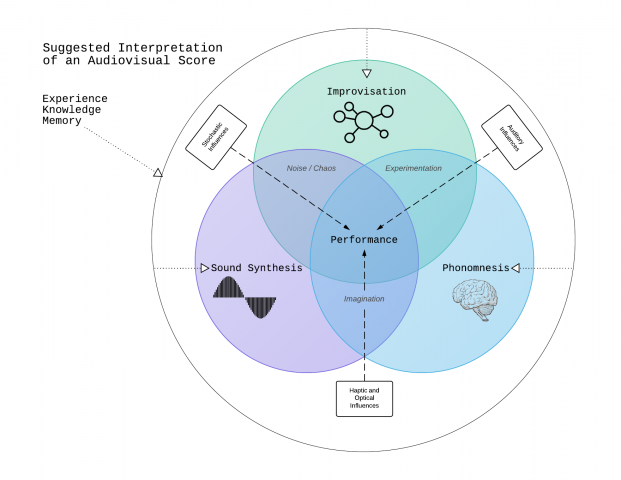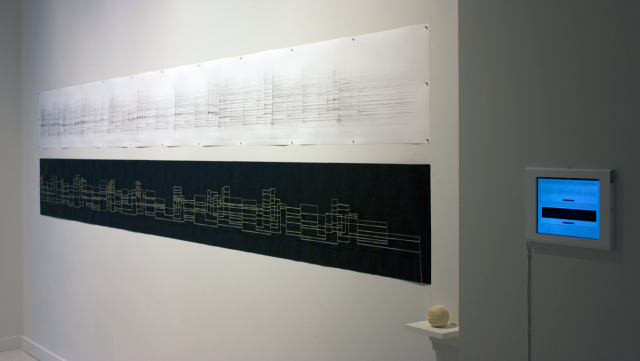
A good stretch of my time working on my MFA in New Media at the Minneapolis College of Art and Design (MCAD) was spent working on my master’s thesis. Here’s the abstract:
This paper explores the idea of mutable, audiovisual scores for improvised musical performances through the description of personal perspectives, practical examples, proposed projects, and research. The author postulates that an audiovisual score can be a useful tool to connect improvising musicians to each other and their audience through the insertion of a mediating audiovisual layer within the work. These systems are used as a primary influential agent for an ensemble of improvisers, providing them with a context for a musical conversation. In contrast to traditional notation and graphic scores, audiovisual scores embrace the chaotic ambiguities of environmental influences giving the music the context of unpredictable everyday events. Presenting an unpredictable audiovisual score parallels the indeterminate improvisation of the ensemble. It activates the last vestige of what remains immutable within traditional forms of notation driven performance inserting it into a mutable layer within the work.
In my thesis you will find detailed, conceptual explanations for many of the projects that I have shared here over the last few years. There are also references to work by many other artists who have provided inspiration to me. If you’re interested please click the link below to view or download the document.
Music with Context: Audiovisual Scores for Improvising Musicians by John Keston

Piotr Szyhalski and I have just finished installing a piece titled, Post-prepared Piano, in the Burnet Gallery at Le Méridien Chambers, Minneapolis. Our installation is part of a show called Interactions and features the work of select MCAD MFA students in collaboration with their mentors. Our piece consists of several components. The first part is a 14′ wide and 17″ tall inkjet print of spectral analysis from a short piano composition that I performed and recorded using my custom built, binaural head microphone (otherwise known as Vincent).
Below the print is an installation that Szyhalski constructed from tarpaper, nails, and one continuous piece of twine. This handmade mapping of the spectral analysis was then photographed and converted back into sound using Michel Rouzic’s excellent application, Photosounder. Thirdly, we installed an iPad with headphones that allows the visitors to hear the original recording, the nails and string version, and a combination of the two layered on top of one another (visit the tablet optimized webapp). The show opens today and runs through February 24, 2013 with an artist’s reception on January 31 from 6pm to 9pm. Read on for more details, photos and sounds. Continue reading →
I put together this animated sequence of the media from Post-prepared Piano to illustrate the relationships between the spectral analysis, the mapping with nails and twine, and the music from the piece. Thanks to Photosounder developer Michel Rouzic for suggesting that I make a video combining the sound and imagery after seeing the documentation I posted a few days ago.
This is an excerpt from a performance by DKO from the MCAD MFA open studio night on December 7, 2012 as discussed in the post Live Binaural Recording of DKO with Oliver Grudem. The document features Oliver Grudem (not shown) who produced the audiovisual score in real-time. The video and sound coming from the LED display and loud speaker below it was broadcast into the performance space as Oliver walked around the Minneapolis Uptown area during a snow storm. The visuals and sound from his walk provided a “score” for us to respond to as we improvised. Oliver was also able to hear our musical reactions to the audiovisual score as he was broadcasting and respond accordingly.
The piece was recorded with my custom built binaural head microphone to capture the sound localization of the performance space. NOTE: It is necessary to wear high quality headphones to experience the binaural effect. The spatial properties of studio monitors are also acceptable but will not produce the same localization of the sound sources. Thanks goes out to Eric Dowell for shooting video of the one hour long performance. I am working on editing a shorter version to briefly summarize the essence of the piece. This 13 minute video is a more in depth snapshot of what the performance entailed.
Examples of work in sound, imagery, and interaction

